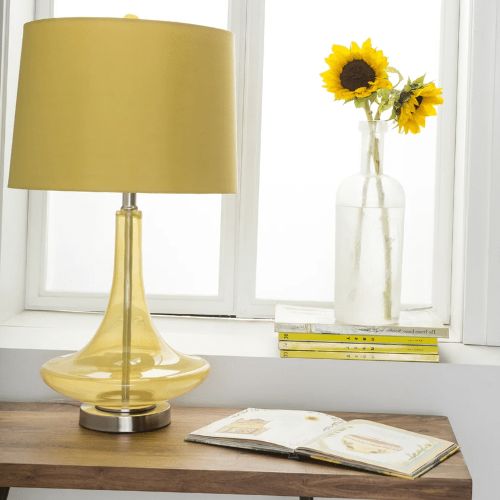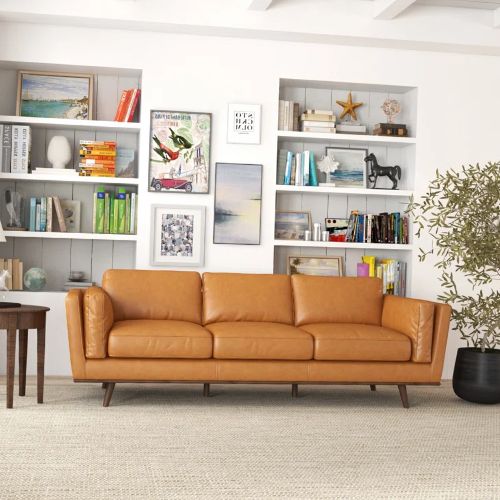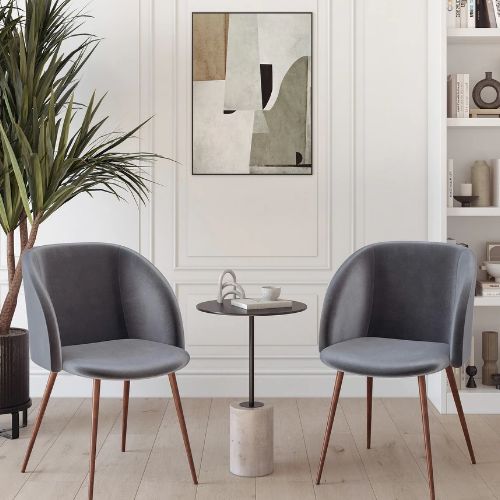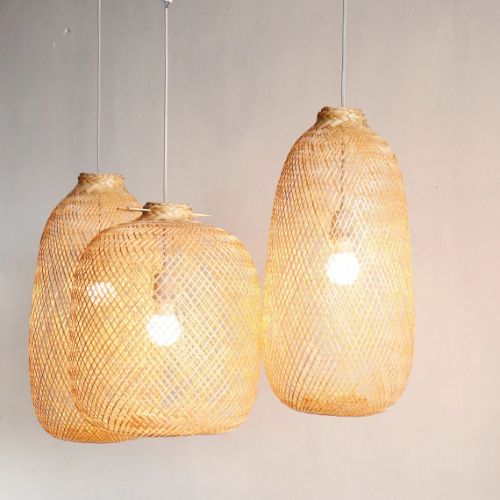Open-plan living is a popular home layout in contemporary interior design and works well for the quick and convenient way we like to lead our lives. An open-plan living and dining room combo helps to create an easy flowing, multi-use space that’s flexible for both eating a meal and sitting back, relaxing.
With two important spaces being combined as one, it can be difficult to know how to arrange furniture in your living room dining room combo without it looking disjointed.
It’s important to keep clear zones with an equal balance between the two areas; choose a harmonious colour scheme, and select furniture items that complement each other to create a cohesive, liveable open-plan layout. Read on to see 25 of our favourite living room dining room ideas!
Our Top 3 Picks
Creating a harmonious living/dining area can be quite the challenge. However, with some thoughtful consideration of colours and furniture configurations to complement your wall decor, you’ll have an inviting space that keeps both areas balanced in one cohesive room! We’ve selected 50 great coffee tables all with storage options for you but first check out our top 3 picks that is best for colour pop, small spaces, and a classic looking style
Living Room Dining Room Combo Layout Ideas
1. Minimalist Living Room and Dining Room Combo
Minimalist style is ideal for open-plan living as it focuses on texture, light and form rather than colour.
This style is a great idea for small living room dining room combos as it allows for a free-flowing space without clutter that can overwhelm the room.
Keep light fittings the same (or very similar) throughout to ensure total harmony and balance.

Pros
- Creates a light, spacious environment.
Cons
- Can lack visual interest if not accessorised well.
2. Narrow Living Room Dining Room Combo
If you have a narrow dining and living room together, it can be hard to style as you’ll want to ensure the space feels open and spacious.
Using circular shapes in items such as coffee tables, mirrors and artwork can help to break up harsh lines and create the illusion of space. Avoid bulky furniture, such as this trunk coffee table, which feels clunky in such a tight space.

Pros
- Adding round shapes will create illusion of space.
Cons
- Large and bulky furniture won’t work well in a narrow room.
3. Farmhouse Living Room Dining Combo
Farmhouse style is perfect for those who like rustic interiors with exposed, natural wood and calming neutral tones. This dining room living room combo creates a warm, family-friendly space that blends each zone together with its neutral colour scheme.
The dark wood floor adds to the cohesive feel of the room. The addition of a coffee table flower arrangement would add a gentle touch of colour and some added height and texture to the room.
Pros
- Warm, welcoming style
- Perfect for relaxed environment
Cons
- Won’t work for those who like traditional, formal styles
- Darker colours don’t suit this scheme
4. Small Living Room Dining Room Combo
Don’t be afraid to style your small living dining space as they can look just as great as larger rooms. Whilst you may be tempted to apply the “less is more” rule, that really isn’t necessary.
Play with layers, add colour and design with wall art, opt for compact furniture, such as a space saving dining table or coffee table, and choose an accent colour to litter throughout both zones. This space shown could be lifted with an additional pop of colour through use of simple accessories.
Pros
- Less isn’t always more so you don’t need minimal possessions to make this work.
Cons
- ou might not be able to accommodate larger furniture such as a big dining table.
5. Large Living Room Dining Combo
If you’re lucky enough to have a large living and dining area, then you can really push style boundaries and create very defined zones but remember to ensure they still tie in together. This space uses an oversized rug to clearly separate the relaxed living space from the more formal dining area. The warm wood tones of the dining chairs perfectly complement the toffee-toned leather and gold accents in the living room.

Pros
- Plenty of space to create defined zones.
- Larger spaces allow you to balance formal and casual together with ease.
Cons
- Too much space between the two zones can leave the room feeling disjointed.
6. Traditional Living Room Dining Combo
Traditional living and dining room spaces tend to have a more formal style. The dark wood of the dining table and chairs helps to create that with the upholstered seats at the heads of the table work to tie in the soft furnishings of the living space. The dining table rug creates a clearly-defined boundary between the two spaces within the open plan layout.

Pros
- Works well for those wanting more a more formal living dining room combo
Cons
- Wouldn’t suit most modern homes
7. Bold Living Room Dining Combo
Bold colours and colour blocking are great for open plan living and dining rooms as you are easily able to define separate zones for each area.
You could even use different coloured paints, that complement each other, on the walls for the dining and living sections.
This room has used the furniture to create its divide whilst keeping the walls the same shade for smooth transition between seating and dining.

Pros
- Colour blocking can create clear living and dining zones.
Cons
- Strong colours don’t always work as well in smaller spaces as they can make rooms seem smaller than they are.
8. Long Rectangle Living and Dining Combo
If you have a longer open plan living dining space, you could try using floating furniture pieces within the middle of the room like this dining table shows.
The large sectional with oversized rug creates a clearly-defined living area that is open and inviting. However, if you want a more back-to-back look, a sofa in the middle of the floor will also create sections and even help to make a pathway across the room that makes full use of the floor space.
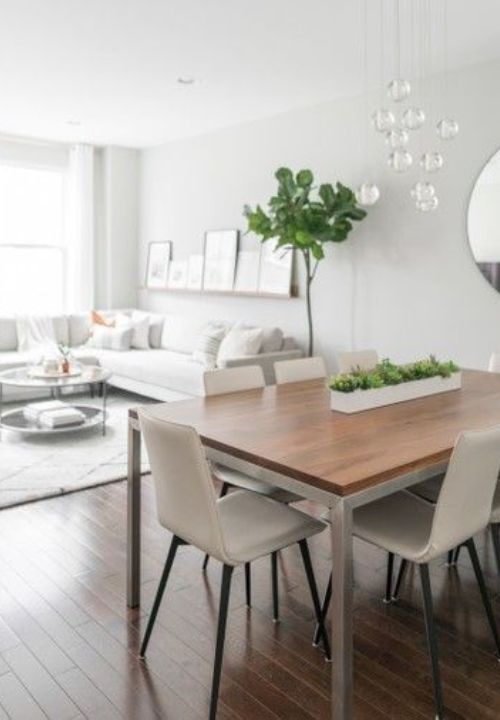
Pros
- Oversized rug relaxed the living area.
Cons
- If the sofa was the other way around it would create clearer sections.
9. Simple Modern Living Room Dining Room Combo
Modern styles are perfect for open plan living dining spaces as they offer light and simple designs that don’t overpower spaces. This modern room uses cool wood tones and black accents to add depth. Tying the chairs in with the sofa ensures a beautifully-blended room.

Pros
- Keeps room light and simple.
Cons
- Brighter colours don’t always suit this theme.
10. Mid-Century Modern Living Room Dining Room Combo
Combine the best of traditional and modern with mid-century living to create an elegant space with some quirky touches. The round shapes lend themselves perfectly to small spaces to give the illusion of space. Littered with colour pops and brass accents from the lighting, this is a warm inviting space that blends formal and casual together beautifully.
Pros
- Brass tones add warmth.
- Mid-century modern style is a good mix of casual and formal.
Cons
- Darker colours can overwhelm smaller spaces.
11. Cottage Style Living Room Dining Room Combo
Create a cosy cottage space with a slouchy corner sofa complete with plenty of cushions and warm wood furniture pieces. If you have beams and exposed wood in your cottage style room, like this space, try to tie this in with items such as your dining table for a balanced look.
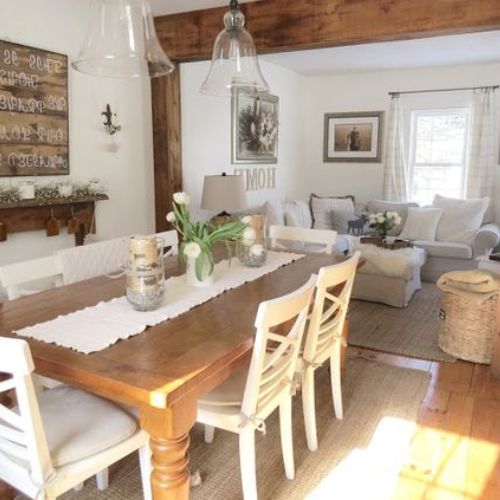
Pros
- Wood tones create warm, cosy style.
Cons
- Cottage spaces can look quite cramped and dark.
12. Space-Saving Living Room Dining Room Combo
Small rooms don’t mean you can’t have an open-plan living and dining space, as this room demonstrates. You’ll need to be clever with your layout and make the most of every space. You could do away with the ottoman used here and use space-saving laptop coffee tables that can be easily tucked away when not needed.

Pros
- Space saving furniture can allow you to have a small living dining room combo.
Cons
- You might have to forgo some common living dining furniture such as sideboards and tv units.
- Storage space might be limited.
13. Classic Living Room Dining Room Combo
Navy and white is a timeless colour combo that will make for an elegant living and dining room layout. Using features such as this large, patterned rug ensure that the colour scheme remains the same throughout whilst still creating clear, distinct sections.

Shop the Look:
Pros
- Classic styles never go out of fashion.
14. All-white Living Room Dining Room Combo
An all-white combined living dining room offers a chic, streamlined space with a contemporary edge. This white space is bright and airy, making the most of the natural light to really open up the room.
Combined with some neutral, textured cushions and throws to add depth, it leaves a fresh finish. Add in some potted plants for an injection of colour that provides instant lift.

Pros
- Creates a bright and airy space.
- Allows the open plan room to flow.
Cons
- Needs lots of textures for depth.
- Can be quite bland and lack personality.
15. Back-to-back Living Room Dining Room Combo
Using a back-to-back layout helps to create defined zones whilst retaining the seamless nature of this open plan room. Ensure the room flows by using the same colour scheme throughout.
The blue colour of these dining room chairs is replicated in the picture and rug in the living room zone which helps to create clear points of difference whilst still ensuring a harmonious setting.

Pros
- Creates clearly defined zones.
Cons
- Separates the two rooms reducing clear pathways.
16. Modern Luxe Living Room Dining Room Combo
With warm grey tones, this modern dining room family room combo has a touch of luxury with the velvet dining chairs, marble table and opulent chandelier light fitting.
Combined with hints of silver and mirrored furniture, this sophisticated space flows in an effortlessly chic manner that lends itself perfectly to open plan living. Introduce some darker tones with cushions and throws to add some depth.
Pros
- Chic, understated theme.
Cons
- Lacks vibrancy.
17. Warm Living Room Dining Room Combo
A living and dining room is designed together with living in mind and, as such, you’re likely going to want a warm, inviting area to relax and eat in. This elegant room with rich terracotta walls is perfectly balanced with brushed gold notes and deep wood tones. Add brightness with plenty of lighting, such as recessed can lights and table lamps.

Pros
- Unusual, statement theme.
- Warm and inviting.
Cons
- Can be too powerful for small spaces.
- Terracotta can look dated if not styled well.
18. Neutrals Living Room Dining Room Combo
Neutral colour schemes are a classic design that will always be on-trend and this layout shows how timeless it can be. The soft natural colours of the furnishings within this room blend beautifully, and the darker tone of the sofas provides a clear boundary for each section. Make use of walls by adding pictures to them to play with height and dimension.
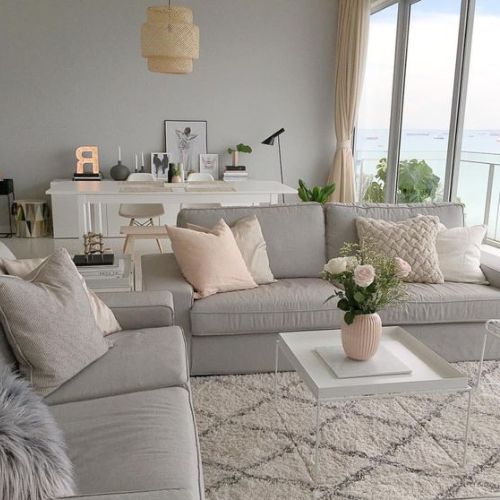
Pros
- Classic colour palette.
- Soft, light, and elegant.
Cons
- Not very unusual and can lack personality.
19. Scandi Living Room Dining Room Combo
Scandi-inspired interiors are big news; their simple, calm designs offer clutter-free style that is perfect for an open-plan living and dining room together. The light, clean furniture and accessories used within this room keep it bright and inviting, whilst the natural-toned rug and placemats add texture.

Pros
- Clean and minimal.
Cons
- Requires accessories to add texture.
20. Matching Living Room Dining Room Combo
Matching décor creates a well-balanced environment, and this is especially important in a space with a living room and dining room combined. If you have mismatched items that don’t complement each other it can create a disjointed feeling. The matching items can be subtle, or more obvious like the matching wood tones shown here that unite the two areas.

Pros
- Helps to create a harmonious, flowing space.
Cons
- Matching furniture can create a dated, unnecessarily symmetrical style that lacks personality.
21. Monochrome Living Room Dining Room Combo
Monochrome is a great base palette for those who want to add some subtle colour pops to their room, but it also offers a luxe look on its own. Black and white work in perfect harmony together for an elegant style that ensures the room is united. Add in a rug to the sofa area for a more clearly-defined zone.

Pros
- Black and white themes are classic.
- Provides a perfect base if you want to accessorise with other colours.
Cons
- Can lack visual impact if there isn’t enough of each colour.
- Contrast can be overpowering.
22. Grey Living Room Dining Room Combo
Grey is a versatile, modern-day neutral tone that leaves rooms feeling elegant. If you want to go for a completely grey room, use various shades of the colour to create visual points of interest. You could add in some silver accessories for a brightening effect.

Pros
- Grey is an elegant, classic colour.
- Modern day neutral.
Cons
- Can be dull without accessories.
23. Industrial Living Room Dining Room Combo
Industrial-style décor often highlights architectural aspects of the room. Using raw, textured wood and black metals further adds to this casual, unfinished design. Add in potted plants or indoor trees like this room to soften the harshness this décor can create, as well as injecting a fresh colour for added brightness.

Pros
- Modern.
- Suits urban styles.
Cons
- Can be quite harsh with the exposed architectural elements and raw wood.
24. Brown Living Room Dining Room Combo
Brown is a sophisticated alternative to beige and grey for those wanting to use neutral tones. Providing more depth, it’s an earthy tone that makes a space feel homely and secure.
Introducing a feature pendant light can add a sophisticated touch that brightens the room for added visibility and ambiance. Using gold accents throughout will brighten the look whilst retaining the classy style.

Pros
- Gold accents can add warmth.
- Inviting setting that can be enhanced with wood furniture.
Cons
- Brown can be quite dated if not styled well.
25. Patterned Living Room Dining Room Combo
As you want to create a cohesive living and dining room combo, patterns are a great tool for creating this. They add shape and texture to a room. By adding in a similar style of pattern or the same one across the living and dining space creates unity. Be sure to keep to similar colours to ensure the look doesn’t become too complicated and messy.
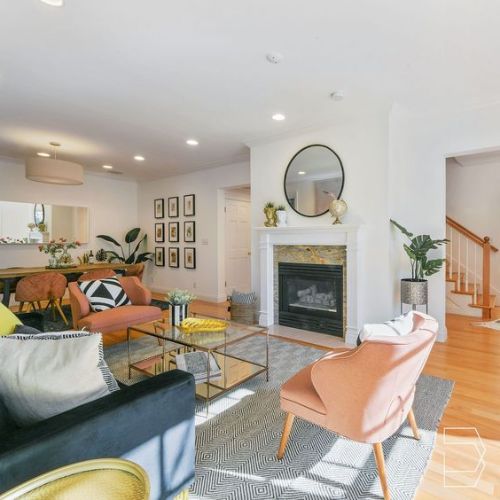
Pros
- An alternative way to make a room flow rather than colour.
Cons
- Can look messy and overwhelming if too many patterns are used.
Summary
Open-plan living and dining rooms may seem like a large, challenging space to layout and decorate but it really isn’t as complicated as you may think! Keep the space balanced, with a cohesive colour scheme throughout and ensure you use accessories to tie the look together.

